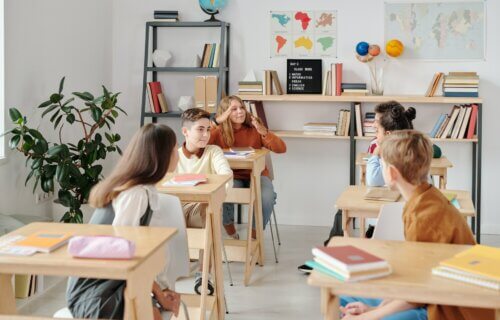BOCA RATON, Fla. — Few people understand us quite as well as our oldest friends, but new research suggests children may not have total control over the bonds they form during elementary school. Researchers from Florida Atlantic University say assigned seats go a long way toward determining children’s friendships.
Specifically, study authors say friendships reflect classroom seating assignments. Students who sit next to, or nearby, one another are more likely to become friends than students seated far away from each other. Additional longitudinal analyses also revealed classroom seating proximity displays a link to the formation of new friendships.
This held true even when a seating chart changed; students were more likely to become friends with their new “neighbors” than with others moving farther away.
“The students in our study spent most of every day with the same 15 or so classmates. By the middle of the school year, there were no unfamiliar peers,” says senior study author Brett Laursen, Ph.D., a professor of psychology in FAU’s Charles E. Schmidt College of Science, in a university release.
“Yet when seat assignments changed, new seatmates were apt to become new friends, consistent with claims that exposure alone is not a sufficient condition for friendship. Apparently, proximity transcends familiarity by providing new opportunities for the kind of exchanges that form the basis of a friendship.”
‘The power of proximity’
Researchers assessed 235 students (129 boys, 106 girls) between ages eight and 11. All of the students were attending a public primary school in South Florida (grades 3-5).
Study authors used teachers’ classroom seating charts to formulate three “forms of proximity” for each pair of students in a given class. “Neighbor proximity” refers to classmates seating right next to one another, either in a row or at a table, as well as kids seated directly across from one another at a table.
“Group proximity,” meanwhile, encompassed classmates deemed neighbors in addition to those deemed near neighbors; either just one seat away in the same row or diagonal to each other at the same table.
Findings in reference to group proximity were the strongest. This suggests, researchers say, that most children are willing (and able) to bypass their nearest neighbors in favor of others seated close enough for sustained communication.
“Of course, students were not glued to their seats; interactions with far-seated peers undoubtedly occurred during lunch, recess and (in some classes) free time activities,” Dr. Laursen adds. “The fact that new friends tended to emerge among the newly near-seated – despite opportunities for engagement with other classmates – underscores the power of proximity in friendship formation.”
Teachers carry a heavy burden when it comes to friendship
The research team speculates that seating arrangements during elementary school are so influential because kids at these ages have few other opportunities to make new, sustained social connections. Put another way, teachers hold a whole lot more power in their seating charts than even they may realize.
“Taken together, our findings highlight the enormous influence that teachers wield over the interpersonal lives of children. With great power comes great responsibility,” Dr. Laursen concludes. “We urge teachers to exercise their power judiciously. Unintended social consequences have been known to arise when adults meddle in the social lives of children.”
The findings appear in the journal Frontiers in Psychology.


Link to the doi, or what are you doing?